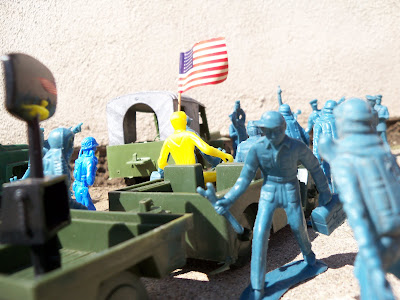
The supersonic B-47 bombers can fly in at speeds of over mach 1. They can drop their bombs and fly out again at the same speed.
These air men are learning first hand about the effects of a massive bombing raid on the ground below.

Naturally, radio contact is maintained by the ground forces with the plane.

Safety teams wear yellow. When live firing there is always the possibility of unexploded munitions. Crews need to be there to determine the safety of the scene.

As you can see, the solid, bare flat desert terrain has been chewed up into a tangled mass of earth.

Naturally, radio contact is maintained by the ground forces with the plane.

Safety teams wear yellow. When live firing there is always the possibility of unexploded munitions. Crews need to be there to determine the safety of the scene.

As you can see, the solid, bare flat desert terrain has been chewed up into a tangled mass of earth.
Figures by Tim Mee air force set and MPC. Jeeps and truck by MPC.
















































